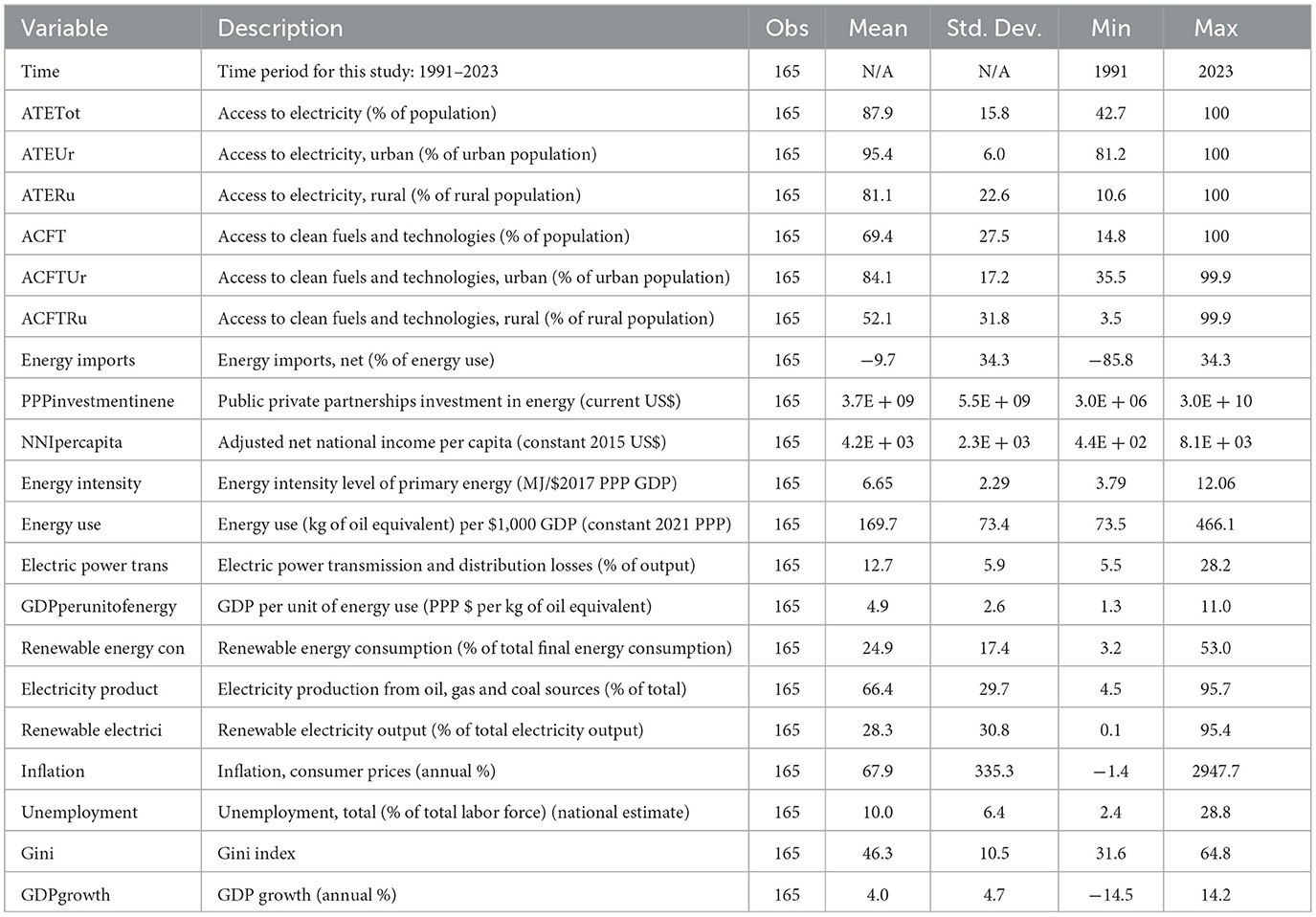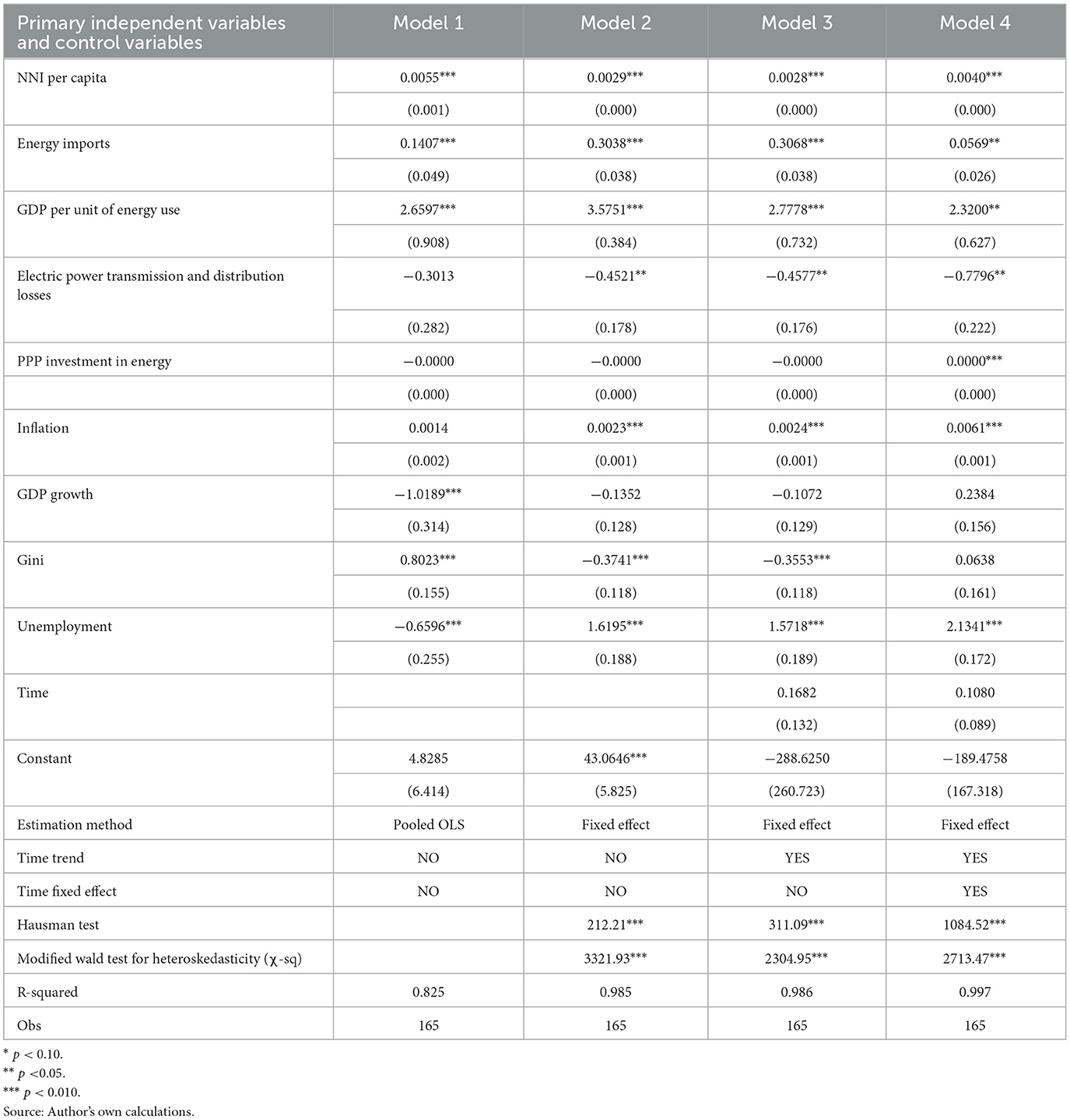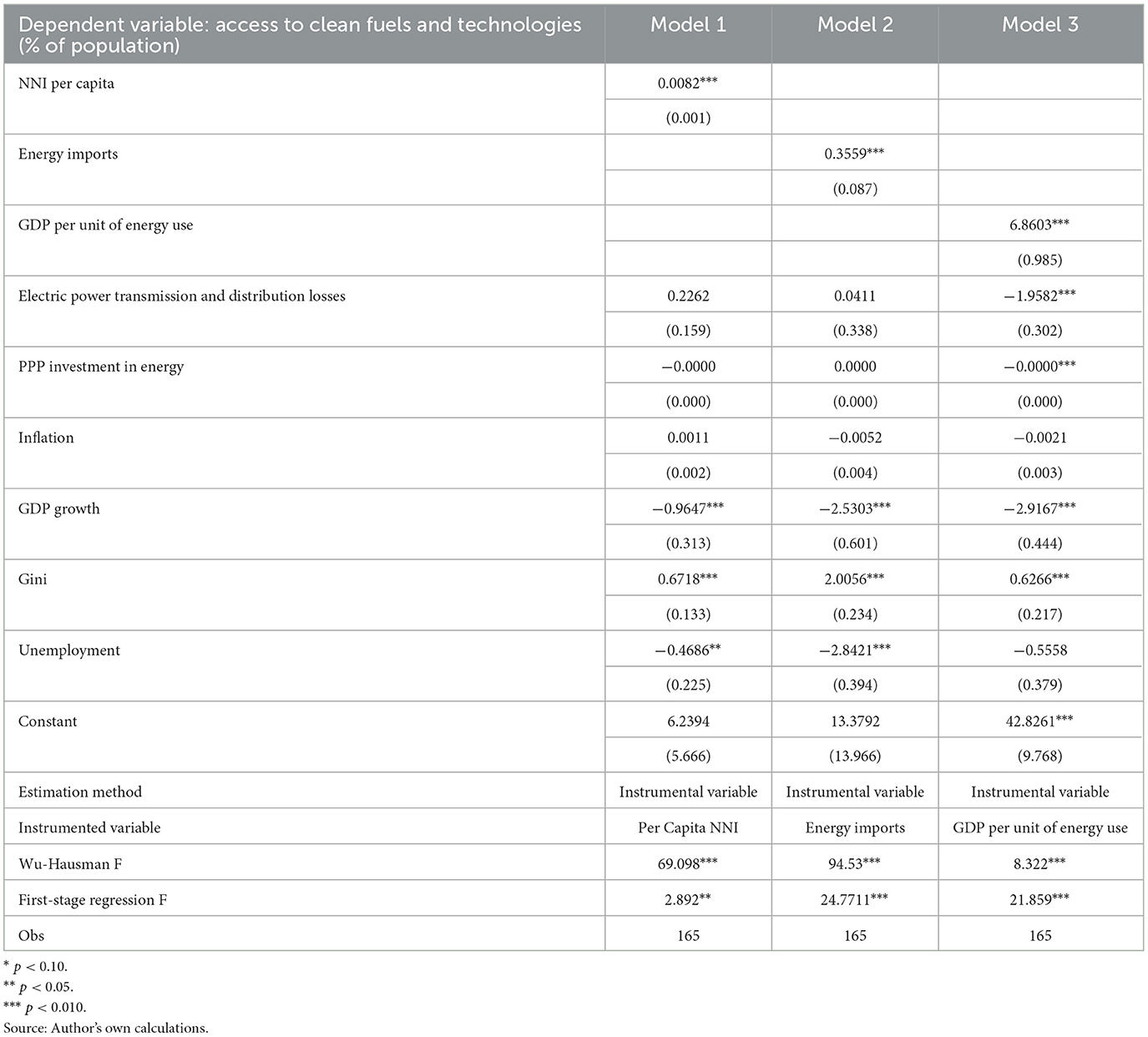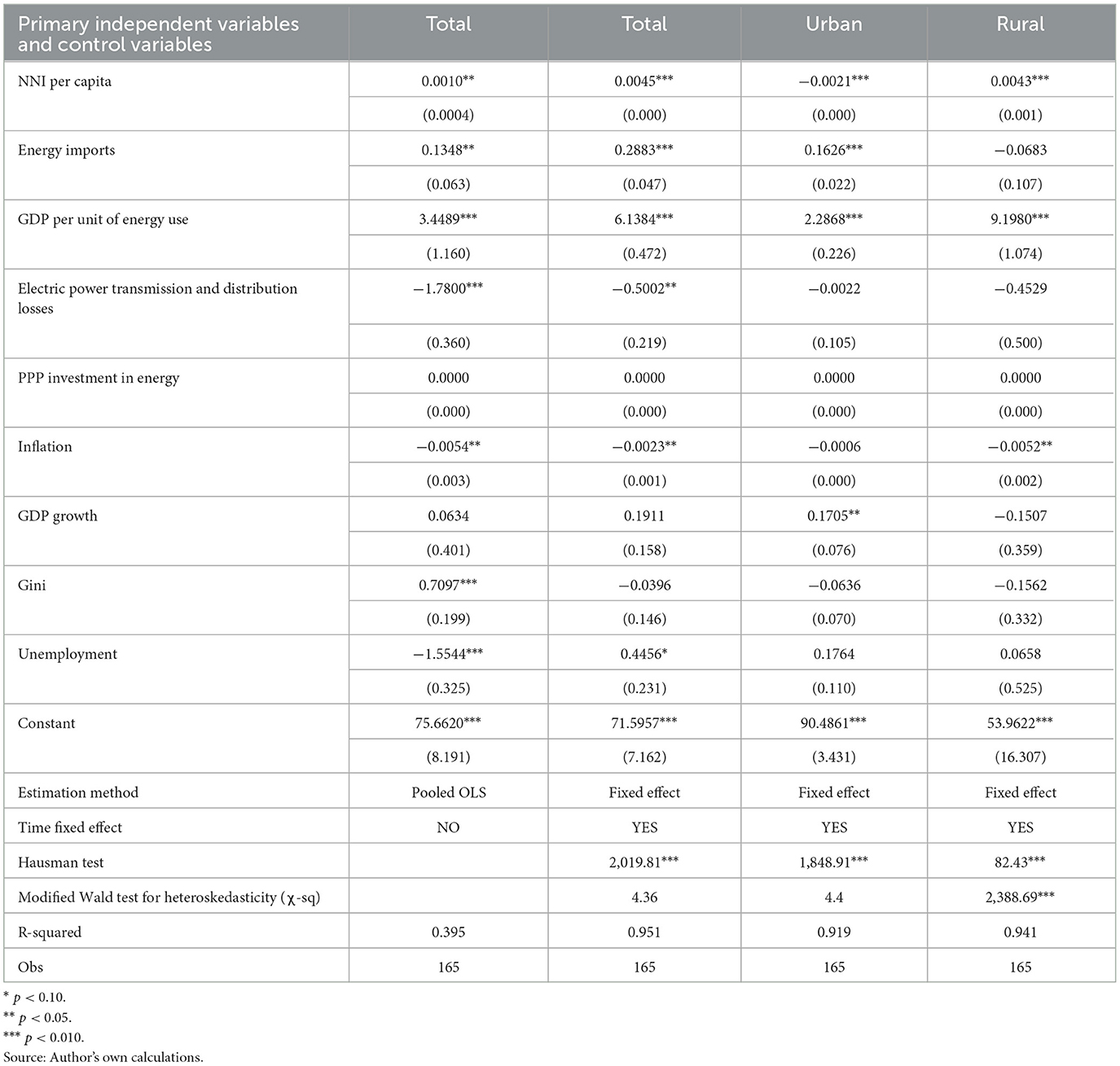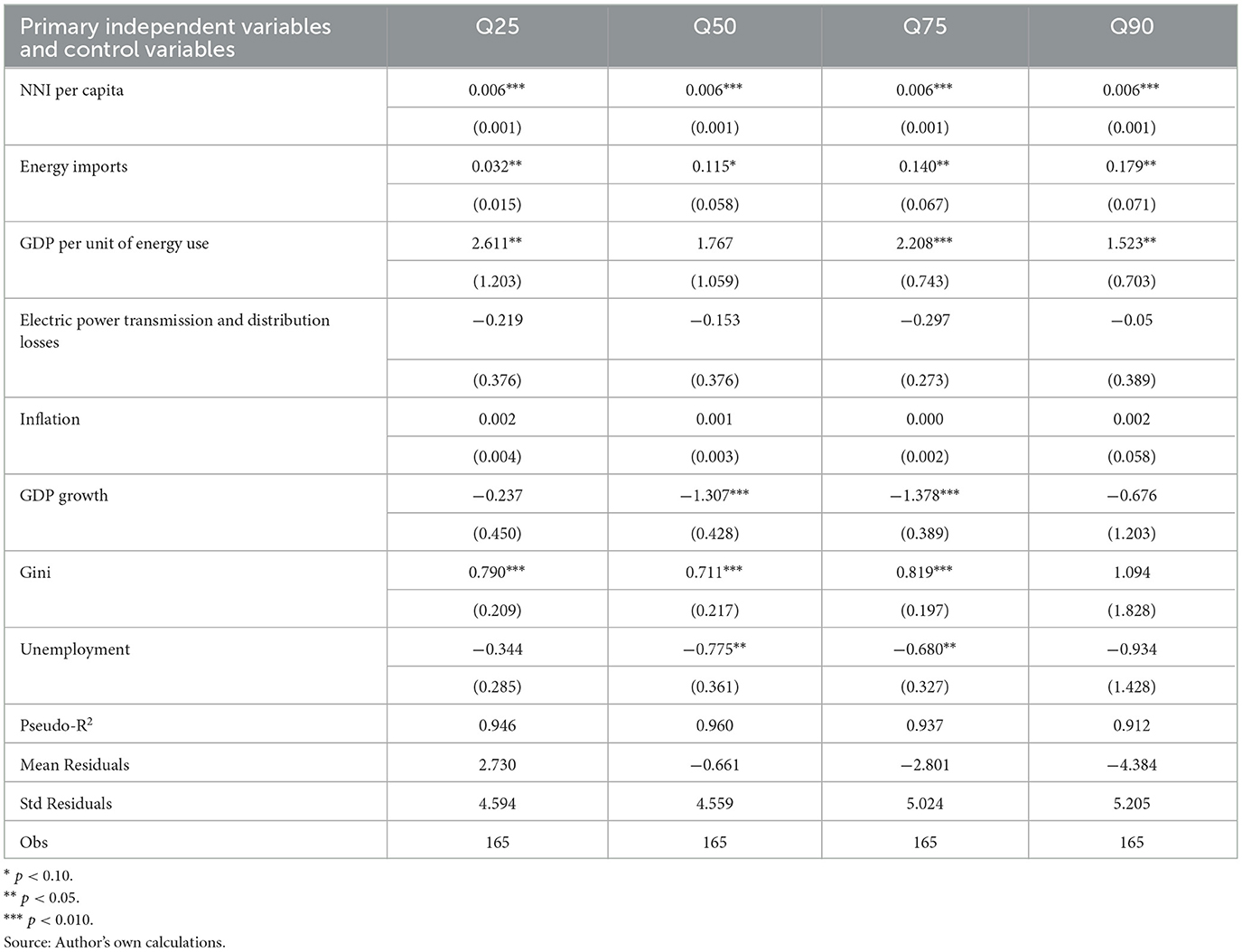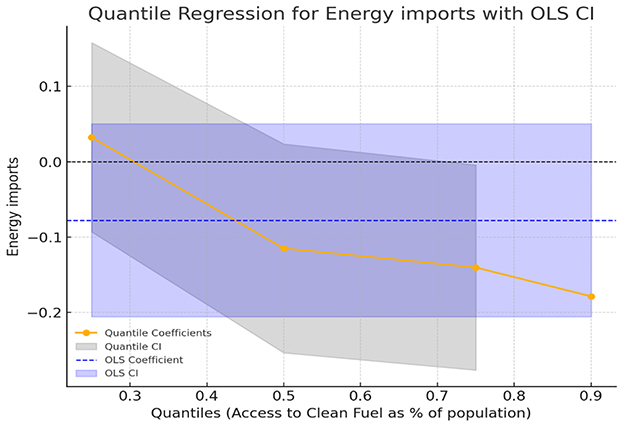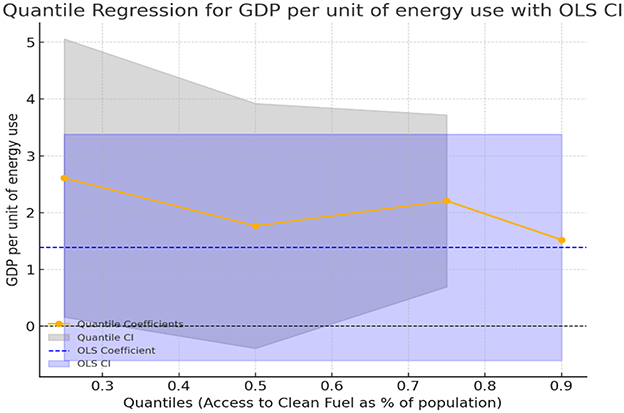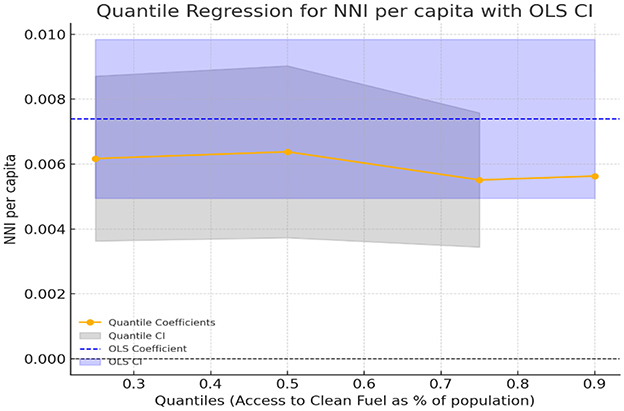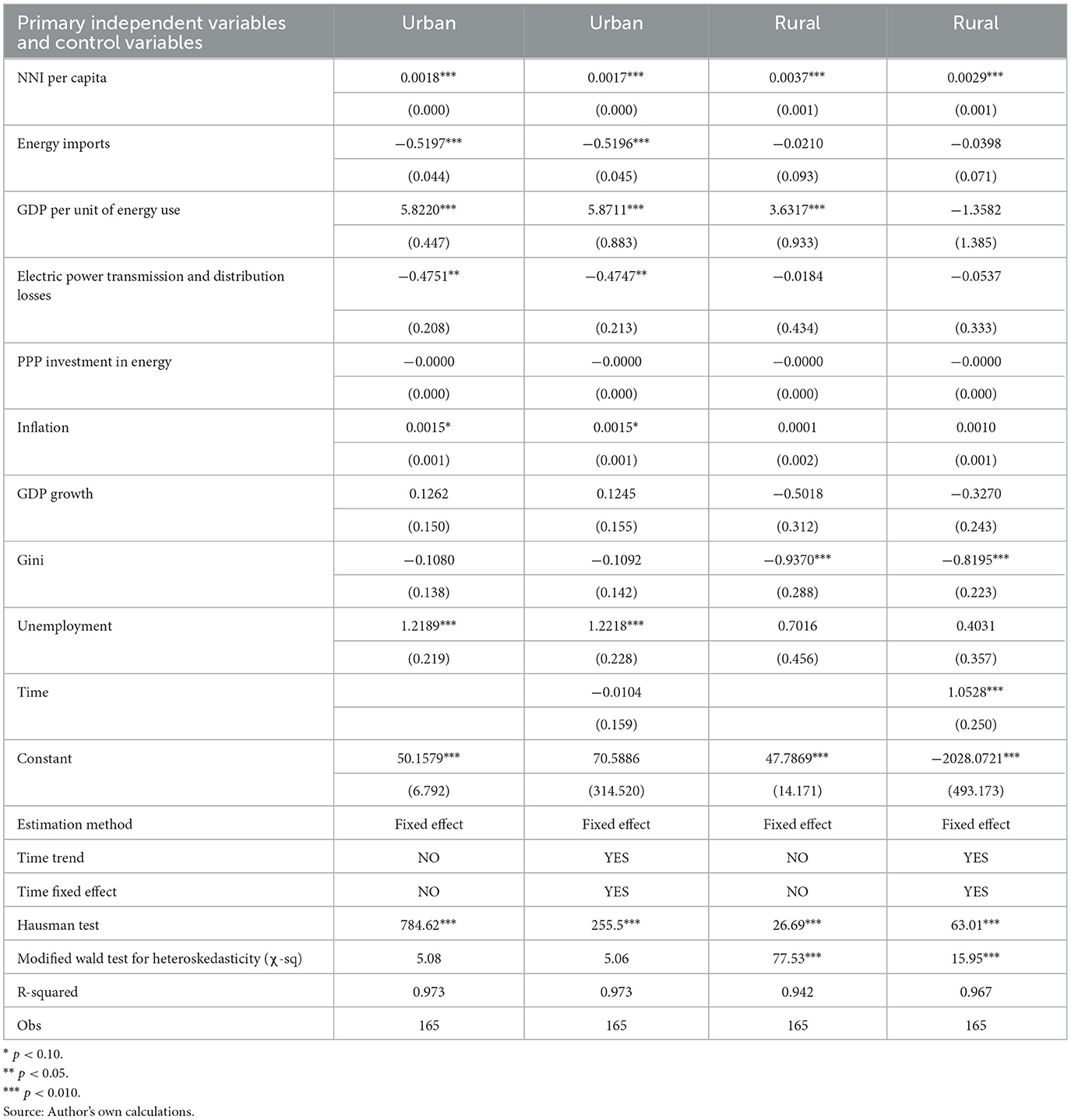- Reserve Bank of India, Kanpur Regional Office, Mumbai, India
Introduction: Energy poverty remains a pressing challenge in emerging economies, particularly in BRICS countries, where significant disparities in clean fuel and electricity access persist across rural and urban populations. Despite global commitments to Sustainable Development Goal 7, the structural determinants of energy poverty including energy availability, efficiency, renewable energy composition, and financial capacity remain poorly understood, especially regarding rural-urban disparities and their distributional effects across different access levels.
Methods: This study employs panel data from 1991 to 2023 for BRICS countries, using access to clean fuels and technologies as the primary measure of energy poverty. The empirical strategy combines three robust econometric approaches: two-way fixed-effects models to control for unobserved heterogeneity, instrumental variable techniques to address endogeneity concerns, and quantile regression to examine distributional effects across deciles of clean fuel access. Key determinants analyzed include energy imports, GDP per unit of energy use (efficiency proxy), and per capita net national income (financial capacity proxy), alongside comprehensive control variables.
Results: The analysis reveals significant rural-urban disparities in energy poverty determinants. Energy imports positively influence urban clean fuel access but show limited impact in rural areas due to infrastructure constraints. Financial capacity demonstrates stronger effects in rural contexts across all quantiles, with coefficients of 0.0037 (p < 0.01) compared to urban areas. Energy efficiency improvements benefit urban populations, particularly at higher deciles, but have minimal impact on underserved rural communities. Quantile regression results highlight heterogeneous effects, with energy availability becoming increasingly influential at higher access levels while financial capacity remains consistently significant across all quantiles.
Discussion: Findings imply that availability-side gains alone are insufficient to close rural gaps without last-mile distribution and affordability support. Policy should combine decentralized renewables and clean-cooking delivery in rural areas, targeted income support, and urban efficiency standards with tariff designs that incentivise fuel-switching. Sequencing should be context-specific, aligning infrastructure rollout with household capacity to pay, to accelerate progress toward SDG 7.
1 Introduction
Energy poverty, defined as the lack of access to affordable, reliable, and modern energy services, remains a critical challenge for achieving sustainable development, especially in emerging economies such as the BRICS nations. It directly impacts human wellbeing, economic development, and environmental sustainability, disproportionately affecting rural populations while exacerbating urban inequalities (Modi et al., 2006). Access to clean fuels and electricity is a cornerstone of socioeconomic development, yet millions remain deprived, reflecting persistent barriers rooted in financial, infrastructural, and policy shortcomings (Barnes et al., 2011). Despite global commitments to Sustainable Development Goal 7- ensuring access to affordable, reliable, sustainable, and modern energy for all- the structural determinants of energy poverty remain poorly understood, particularly in the context of urban-rural disparities (Bazilian and Pielke, 2013; Sovacool et al., 2012). Previous research has highlighted the significance of energy availability, efficiency, renewable energy composition, and financial capacity in addressing energy poverty (Ang, 2015; Bouzarovski, 2014), yet these factors exhibit considerable heterogeneity across regions and socioeconomic groups (Dincer, 2000; Foley, 1992). Rural areas often face systemic challenges such as inadequate infrastructure and limited financial resources, while urban areas grapple with energy efficiency issues and affordability constraints (Khandker et al., 2010; Ranjan and Hughes, 2014).
This paper aims to address two critical gaps in the literature: the rural-urban disparities in the structural determinants of energy poverty1 and the heterogeneity of these determinants across deciles of clean fuel access. Using advanced econometric techniques, including fixed effects, instrumental variable, and quantile regression, this study offers a granular understanding of how energy poverty determinants operate across different contexts and levels of access. By incorporating key metrics such as energy imports, renewable energy shares, GDP per unit energy use, and per capita income, this research provides a robust framework to inform policies targeting equitable energy access (Modi et al., 2006; Chakravarty and Tavoni, 2013). This research contributes to the growing body of literature on energy equity by emphasizing the need for tailored, context-sensitive interventions. In addition to addressing infrastructural deficits and financial constraints, the findings highlight the importance of prioritizing efficiency and renewable energy integration to create sustainable energy transitions (Huenteler et al., 2017; Tharakan et al., 2014). The insights from this paper aim to guide policymakers in designing interventions that bridge rural-urban gaps and align with global energy goals (Lee et al., 2019; Bazilian et al., 2012). Recent analyses underscore the urgency of this inquiry in light of evolving global dynamics. For example, Li et al. (2024) emphasize persistent disparities despite aggregate gains, the International Energy Agency (IEA) (2025) documents uneven rural infrastructure deployment, the United Nations (2023) reports Sustainable Development Goal 7 stalling in low-access regions, and the World Bank (2024) highlights financing constraints for rural microgrids. Bhattacharyya and Palit (2016) further demonstrate that decentralized systems can mitigate, but do not eliminate, infrastructure bottlenecks in BRICS rural contexts. These insights reinforce the need for up-to-date, context-sensitive analysis.
Unlike earlier studies that primarily focus on either energy availability or affordability, this paper integrates these dimensions, examining how the availability of clean fuel is influenced by energy availability (measured by energy imports), financial capacity of the users (proxied by per capita net national income), and energy efficiency (GDP per unit energy use). This comprehensive framework provides a more nuanced understanding of energy poverty and its drivers, building upon prior research (Bhattacharyya, 2012; Rao and Pachauri, 2017a,b). By employing fixed effects and instrumental variable techniques, the study mitigates endogeneity concerns, offering robust causal inferences about the determinants of energy poverty. Moreover, the study distinguishes itself by exploring the rural-urban divide, a largely neglected area in cross-country energy poverty analyses. Through quantile regression, it reveals heterogeneity in the impacts of key structural determinants for rural and urban contexts across the distribution of clean fuel availability, adding depth to the understanding of spatial disparities in energy poverty (Kanagawa and Nakata, 2008; Sovacool and Dworkin, 2015). For instance, the role of financial capacity and energy efficiency in addressing energy poverty strongly diverges across quantiles for rural and urban areas, while the influence of energy availability displays a homogeneous trend. This structural decomposition approach2 helps uncover the root causes of disparities across clean fuel distribution, showing that inefficiencies in energy usage and limited financial resources stimulate energy poverty, however, it differs from rural to urban areas (Reddy and Williams, 2019; Zhang and Wang, 2019a,b). These findings offer actionable insights for policymakers, emphasizing the need for targeted interventions tailored to rural and urban contexts.
This paper's contributions are threefold. First, it broadens the analytical framework for understanding energy poverty by linking macroeconomic variables with energy-specific factors, thereby addressing gaps in existing research (Alam et al., 2020a,b; International Energy Agency (IEA), 2021). Second, the use of quantile regression to examine rural-urban heterogeneity advances the methodological rigor of energy poverty studies, providing insights that align with global calls for inclusive energy policies (UNDP, 2020a,b; World Bank, 2021a,b). Third, the decomposition analysis highlights the structural barriers that perpetuate energy poverty, offering a foundation for designing targeted strategies to reduce disparities and improve energy equity (Pachauri and Rao, 2017). In the context of BRICS countries, where energy poverty remains a critical challenge for sustainable development, this study underscores the importance of addressing economic, structural, and spatial dimensions of energy access. It provides evidence-based recommendations to enhance financial capacity, improve energy efficiency, and ensure equitable energy availability. These findings not only inform national policies in BRICS countries but also offer valuable insights for global efforts to alleviate energy poverty (Gaye, 2007; Sovacool and Dworkin, 2015). By addressing these critical gaps in the literature, this study provides a robust foundation for future research. It calls for a deeper exploration of temporal trends3 and sectoral differences, as well as longitudinal studies to understand the evolving dynamics of energy poverty in emerging economies.
2 Brief review of literature
Energy poverty remains a pervasive challenge globally, with diverse causes and consequences across countries. Research has extensively examined its drivers, focusing on socio-economic, geographic, and policy dimensions. Despite these efforts, significant gaps remain in understanding the structural determinants of energy poverty, especially in emerging economies.
2.1 Theoretical framework
Energy poverty has emerged as a critical research area due to its profound implications for socio-economic development and environmental sustainability. Existing theoretical frameworks broadly examine supply-side, demand-side, and spatial dimensions (Bazilian et al., 2014; Sovacool, 2018) to understand energy poverty's structural and systemic causes. Supply-side approaches emphasize energy availability, infrastructure, and geopolitical determinants. The “energy ladder” model (Bhattacharyya, 2012) theorizes that as economic development progresses, households transition to cleaner and more efficient energy sources. However, this model assumes linear progression and neglects institutional factors, such as energy market regulations and subsidies. Kanagawa and Nakata (2008) extend this discussion by highlighting the role of energy imports and domestic production in shaping access to clean energy. These supply-side theories emphasize the structural barriers to energy availability but often overlook the interaction between macroeconomic variables and spatial inequities. Demand-side theories focus on affordability, household income, and energy efficiency as determinants of energy access. Reddy and Williams (2019) propose that energy affordability is intricately linked to socio-economic inequalities, as lower-income households spend disproportionately on energy. Pachauri and Rao (2017) highlight that financial capacity, often measured through household income, is pivotal in determining access to clean fuels. Additionally, energy efficiency plays a dual role, enhancing affordability and reducing environmental impact (Alam et al., 2020a,b). However, these frameworks inadequately address the spatial heterogeneity of energy poverty across rural and urban contexts. Energy justice, an emerging conceptual framework, broadens the focus beyond availability and affordability to include equity and fairness in energy access (Jenkins et al., 2016). This framework introduces three pillars: distributive justice, which examines the equitable distribution of energy resources; procedural justice, which addresses participation in decision-making; and recognition justice, which considers the unique needs of marginalized populations. These dimensions align with global calls for inclusive energy policies but remain underexplored in quantitative cross-country analyses, particularly regarding BRICS countries.
Spatial frameworks emphasize the rural-urban divide in energy access. Sovacool and Dworkin (2015) argue that rural areas are disproportionately affected due to limited infrastructure and geographic isolation, while urban areas often benefit from more robust energy systems. Zhang and Wang (2019a,b) integrate socioeconomic perspectives with spatial dimensions, identifying that disparities in financial capacity and infrastructure are significant contributors to energy poverty. However, these frameworks lack granularity, as they often fail to capture variations across different segments of the population. Recent literature has called for integrated approaches that combine supply-side, demand-side, and spatial dimensions to provide a holistic understanding of energy poverty (Rao and Pachauri, 2017a,b). These approaches incorporate macroeconomic variables, such as GDP per capita and energy imports, alongside energy-specific factors like efficiency and clean fuel availability. While integrative frameworks address theoretical gaps, their application is limited in emerging economies, where data inconsistencies and endogeneity concerns often hinder robust analysis.
This study addresses the limitations of existing frameworks by adopting a decomposition approach that integrates supply-side, demand-side, and spatial dimensions. By examining BRICS countries, it highlights the interplay between energy availability, financial capacity, and energy efficiency as determinants of energy poverty. Unlike prior studies that treat energy poverty as a uniform phenomenon, this research uncovers critical variations between rural and urban contexts. For instance, the findings indicate that financial capacity and energy efficiency have stronger impacts in urban areas, while energy availability demonstrates a more homogeneous influence across regions. These insights align with energy justice principles, addressing distributive and recognition justice4 by identifying structural barriers unique to different demographic groups. This study advances theoretical frameworks by synthesizing macroeconomic variables, energy-specific factors, and spatial disparities. Its findings provide a foundation for targeted interventions to enhance energy equity, efficiency, and sustainability in BRICS countries, supporting global efforts to achieve sustainable development goals (Pachauri and Rao, 2017; UNDP, 2020a,b).
2.2 Cross-country evidence
In developed countries, energy poverty is often analyzed through affordability metrics. Boardman (1991) introduced the concept of “fuel poverty” in the UK, emphasizing income thresholds and energy efficiency as critical determinants. Subsequently, Bouzarovski and Petrova (2015) expanded the discussion to include energy justice, highlighting disparities in energy access across socio-economic classes in Europe. Healy and Clinch (2002) evaluated the health impacts of energy poverty, finding a significant correlation between insufficient heating and health outcomes in cold climates. These studies underscore the importance of energy efficiency and financial capacity but are primarily limited to developed contexts.
In developing nations, energy poverty is predominantly influenced by access to infrastructure and clean energy sources. Pachauri and Spreng (2011) examined energy access in South Asia, identifying economic development and energy policy interventions as key enablers. Similarly, Khandker et al. (2012) explored the impact of rural electrification in Bangladesh, highlighting substantial socio-economic benefits. Kanagawa and Nakata (2008) assessed the socio-economic impacts of electricity access in rural India, emphasizing that geographic isolation often exacerbates energy poverty. Africa has received considerable attention due to its acute energy access issues. Aklin et al. (2018) found that electrification in sub-Saharan Africa improves educational outcomes and economic productivity but noted significant regional disparities. Matinga and Annegarn (2013) highlighted gendered dimensions of energy poverty in Malawi, emphasizing that women disproportionately bear the burden of energy scarcity. These studies underscore the interplay between infrastructure, financial capacity, and socio-economic outcomes in developing regions.
Cross-country analyses have been instrumental in uncovering macroeconomic and structural determinants of energy poverty. Sovacool (2012) provided a comparative assessment of energy poverty across 19 countries, finding that policy frameworks significantly influence outcomes. Rao and Pachauri (2017a,b) linked energy poverty to broader issues of inequality and sustainable development, identifying energy affordability as a recurring barrier in low- and middle-income countries. Zhang and Wang (2019a,b) explored energy poverty in BRICS nations, concluding that economic growth and energy efficiency play crucial roles in mitigating disparities but highlighting the rural-urban divide as a persistent challenge. Spatial and distributional aspects of energy poverty are critical, especially in diverse regions. Urban-rural disparities in energy access have been extensively documented. Chakravarty and Tavoni (2013) noted that urban areas in India benefit from better infrastructure, while rural regions face significant deficits. Similarly, Sánchez (2010) found stark disparities in clean cooking fuel access across Latin America, driven by economic and geographic factors.
Quantitative studies have leveraged advanced econometric techniques to capture the heterogeneity in energy poverty drivers. Baland et al. (2010) employed panel data to analyze the impact of energy affordability on household welfare across African nations. Dinkelman (2011) applied instrumental variable techniques to measure the socio-economic impacts of rural electrification in South Africa, finding robust effects on employment and productivity. While these studies provide valuable insights, they often lack an integrated approach that captures the interaction between macroeconomic variables, energy-specific factors, and spatial disparities. Despite extensive research, critical gaps persist in the literature. Many studies focus on either energy availability or affordability, neglecting the integrated impact of these factors alongside energy efficiency. Moreover, rural-urban disparities are underexplored in cross-country analyses, limiting the understanding of spatial heterogeneity in energy poverty drivers (Sovacool and Dworkin, 2015; Pachauri and Rao, 2017). Existing literature often fails to address endogeneity concerns, leading to limited causal inferences. These gaps underscore the need for comprehensive, robust frameworks to analyze energy poverty across diverse contexts.
2.3 Evidence from BRICS countries
The BRICS nations (Brazil, Russia, India, China, and South Africa) face significant energy poverty challenges, reflecting their diverse economic, geographic, and socio-political contexts. Studies on these countries have explored the intersection of energy access, economic growth, and environmental sustainability, providing valuable insights but also revealing critical research gaps. In India, energy poverty research often highlights the rural-urban divide. Bhattacharyya and Palit (2016) examined the role of decentralized energy systems, such as mini-grids, in improving rural electrification. They found that while these systems address infrastructure deficits, affordability remains a barrier for low-income households. Similarly, Sahoo and Shrimali (2013) assessed the impact of renewable energy policies, emphasizing the need for more inclusive policy frameworks to expand energy access in rural areas. In China, rapid industrialization has reduced energy poverty, but disparities persist, particularly in rural and remote regions. Zhang et al. (2018) explored the role of energy efficiency and renewable energy policies in bridging these gaps, identifying regional disparities in policy implementation. Wang and Lin (2017) focused on urban households, finding that rising energy costs disproportionately affect low-income populations, highlighting the affordability dimension of energy poverty. In South Africa, research has emphasized the legacy of apartheid in shaping unequal energy access. Monyei et al. (2018) found that electrification programs have improved access, but socio-economic inequalities and reliance on coal-based energy continue to perpetuate energy poverty. Brazil faces challenges related to energy affordability despite high electrification rates. Campolina et al. (2017) analyzed the impact of energy subsidies on low-income households, emphasizing the need for sustainable mechanisms to balance affordability and fiscal responsibility. Russia, while energy-rich, experiences energy poverty due to inefficiencies and infrastructure disparities. Stepanova (2020) highlighted the need for modernized energy infrastructure in rural areas to address systemic inefficiencies.
Despite extensive studies on energy poverty, a critical gap persists in comprehensively integrating supply-side, demand-side, and spatial dimensions. Existing research often isolates energy availability, affordability, or efficiency without exploring their combined impact, particularly in BRICS countries. Moreover, rural-urban disparities remain underexplored in cross-country analyses, limiting understanding of spatial heterogeneity. By employing robust econometric techniques and a unified framework, this study addresses these gaps, offering nuanced insights into the structural determinants of energy poverty and providing actionable evidence for targeted policy interventions. To address the prevailing gap in the literature, this paper answers the following questions in this paper: (a) how do energy availability, financial capacity, and energy efficiency influence energy poverty in BRICS countries? (b) What are the rural-urban disparities in the structural determinants of energy poverty? (c) How does the heterogeneity in clean fuel access determinants across poverty quantiles vary between rural and urban populations? d) What policy interventions can effectively address spatial and socio-economic disparities in energy poverty within BRICS nations?
3 Data and variables
The data utilized in this study is derived from the World Development Indicators (WDI) database provided by the World Bank. This comprehensive dataset provides country-specific and time-series data across socio-economic and environmental indicators, making it highly suitable for exploring the multifaceted drivers of energy poverty. The dependent variable in this research is Access to Clean Fuels and Technologies (ACFT), expressed as the percentage of a country's population with access. ACFT directly measures energy poverty, reflecting both the availability and affordability of clean energy alternatives. It has been extensively used in prior studies as a reliable proxy for energy equity and poverty (Kanagawa and Nakata, 2008; Rao and Pachauri, 2017a,b). The independent variables in this study include Energy Imports (% of energy use), GDP per unit of energy use (PPP $ per kg of oil equivalent), and Per Capita Net National Income (NNI). Energy imports capture a country's reliance on external energy sources, which can influence energy diversity and affordability, particularly in import-dependent nations (Alam et al., 2020a,b; Sovacool, 2012). GDP per unit of energy use reflects energy efficiency, a critical factor in determining how effectively countries utilize energy resources for sustainable transitions (Bhattacharyya, 2012). Per capita NNI is a proxy for financial capacity, which determines households' ability to afford clean energy technologies, addressing affordability—a key dimension of energy poverty (Pachauri and Rao, 2017; Sovacool and Dworkin, 2015). Together, these variables provide a comprehensive framework to assess energy poverty, combining aspects of availability, efficiency, and affordability.
Additionally, several control variables5 are considered to capture the broader socio-economic and infrastructural context of energy poverty. These include Inflation, Unemployment, Gini Coefficient (income inequality), GDP Growth, Electric Power Transmission and Distribution Losses, and Investment in Energy Infrastructure. These variables address confounding factors that may influence energy poverty independently or interact with the primary determinants. For example, income inequality, measured through the Gini coefficient, is a well-documented barrier to equitable energy access, particularly in rural areas (Reddy and Williams, 2019). Transmission and distribution losses highlight the infrastructural inefficiencies that exacerbate rural energy poverty (Kanagawa and Nakata, 2008). Considering these controls ensures robust and unbiased estimates of the causal relationships between energy poverty and its structural determinants. Table 1 represents the summary of the variables.
Figures 1, 2 illustrate the country-specific heterogeneity and temporal trends in ACFT across BRICS nations. Significant disparities emerge between countries: Brazil and China have achieved high levels of access, exceeding 95% for urban populations, whereas rural areas in India and South Africa remain considerably underserved. These rural-urban disparities reflect long-standing infrastructural and financial inequalities, where rural populations face greater barriers in accessing clean fuels due to logistical constraints and affordability issues (Sovacool, 2012; Pachauri and Spreng, 2011). Temporal trends highlight gradual but uneven progress across countries. India, for instance, has shown marked improvements in rural access over the past two decades, attributed to targeted policy interventions such as the Pradhan Mantri Ujjwala Yojana (PMUY), which subsidizes LPG connections for low-income households (Bhattacharyya, 2012). Brazil and China, on the other hand, have maintained consistently high access rates due to robust energy policies and substantial investments in renewable and centralized energy systems. The temporal data underscores the role of sustained policy efforts and economic growth in improving clean energy access, aligning with Sustainable Development Goal 7 (Rao and Pachauri, 2017a,b).
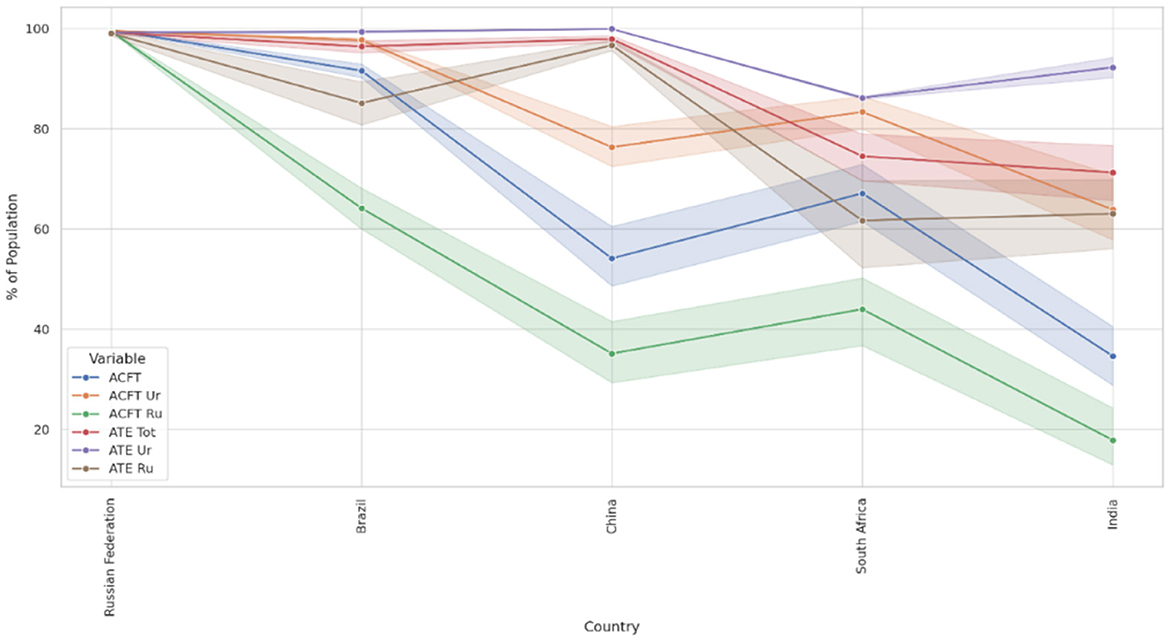
Figure 1. Country-specific heterogeneity-energy poverty determinants. Source: WDI data and author's own calculations.
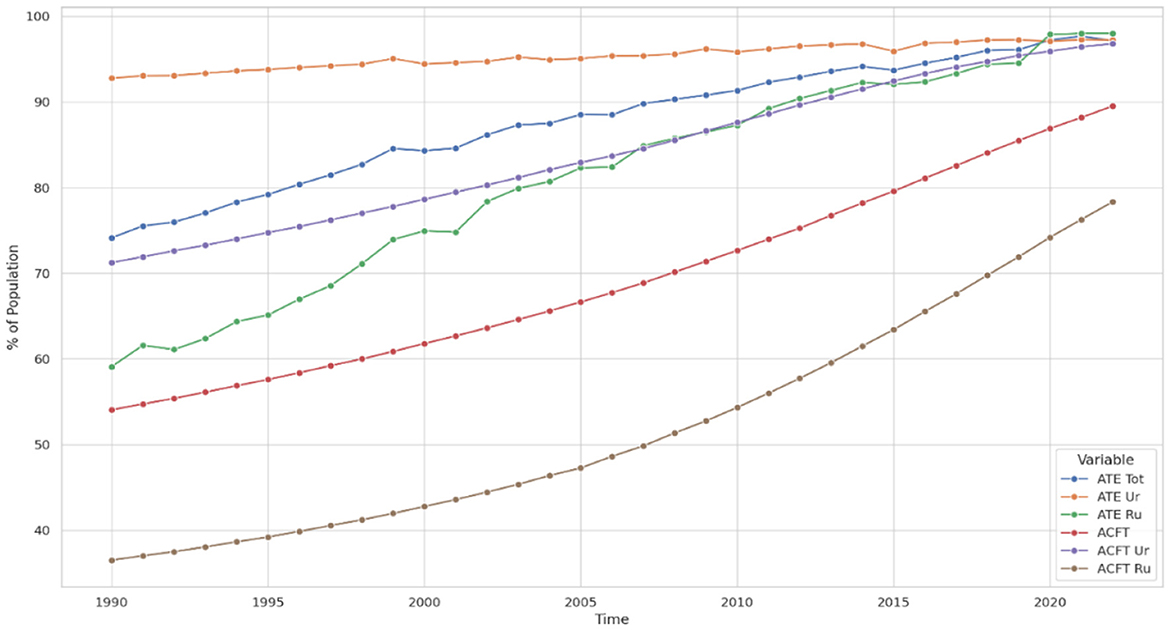
Figure 2. Temporal trends in energy poverty determinants. Source: WDI data and author's own calculations.
The independent variables demonstrate significant cross-country variations. Figure A1 in the Appendix highlights energy imports, where Russia, as a net exporter, reports negative values, contrasting with import-dependent countries like India and South Africa. This divergence underscores the importance of energy self-sufficiency in reducing vulnerabilities to external supply disruptions, which can influence energy affordability and access (Kanagawa and Nakata, 2008; Alam et al., 2020a,b). GDP per unit of energy use indicates higher energy efficiency in Brazil and Russia, compared to lower efficiency levels in India and South Africa, where inefficient energy utilization exacerbates access challenges (Figure A2 in the Appendix). Figure A3 reveals substantial disparities in per capita NNI, with China and Russia reporting higher median incomes, while India ranks the lowest, reflecting financial barriers to energy access in low-income populations. These structural disparities demonstrate how energy imports, efficiency, and income levels interact to shape energy poverty outcomes. Higher energy imports improve access in urban areas with developed infrastructure but fail to address rural deficits due to distribution challenges (Sovacool and Dworkin, 2015). Similarly, energy efficiency can enhance resource utilization in urban areas but requires targeted investments to yield benefits in underserved rural regions (Reddy and Williams, 2019).
4 Empirical strategy
To investigate the determinants of energy poverty and disparities in access to clean fuels and technologies (ACFT) in BRICS countries, this study employs a Two-Way Fixed Effects (TWFE) Model that incorporates both time and entity fixed effects (Wooldridge, 2010; Baltagi, 2008). This approach controls for unobserved heterogeneity across countries and time-varying shocks, enabling a more precise estimation of the impact of structural variables on energy poverty. To address endogeneity concerns, the analysis is complemented with Instrumental Variable (IV) Estimation, while Quantile Regression (QR) is utilized to capture heterogeneity in the effects across different levels of energy access. To implement our empirical strategy, this paper deploys three sets of variables (a) Primary predictors Xit: Energy Imports (EI), GDP per unit of energy use (GDPEN), and Per Capita Net National Income (NNI); (b) Control variables Wit: inflation, unemployment, Gini coefficient (income inequality), GDP growth, electric power transmission and distribution losses, and PPP investment in energy infrastructure, and (c) Quantile-specific predictor Zit: in each quantile regression we enter exactly one element of Zit- either EI, GDPEN, or NNI alongside the full control set Wit to capture its distributional impact on ACFT.
4.1 Fixed-effect (FE) model
The TWFE model is particularly suitable for this study as it accounts for unobserved country-specific factors, such as geographic or cultural attributes, which are constant over time, and global or regional shocks that affect all countries in a given period (Pesaran, 2004; Koenker and Bassett, 1978). For instance, changes in international energy markets or global economic crises could have significant impacts on energy imports, prices, or policy responses. The TWFE model specification is expressed as:
Here, Yit is the dependent variable, i.e., energy poverty indicators, namely, access to clean fuel and technologies and access to electricity in the ith country in the tth year. Xit are the predictor/independent variables- Energy Imports (EI), GDP per unit of energy use (GDPEN), and Per Capita Income (NNI). Wit consists of all the control variables in this analysis such as inflation, unemployment, the Gini coefficient, GDP growth, electric power transmission and distribution losses, and energy investment. αi is the country-fixed effect. μt is the time-fixed effect. The term εit denotes the idiosyncratic error term, capturing unobserved, time-varying shocks and random disturbances specific to country i in year t.
4.2 Instrumental variable (IV) panel regression technique
While the TWFE model addresses time-invariant unobserved heterogeneity and common time shocks, it does not resolve potential endogeneity issues arising from reverse causality, omitted variables, or measurement errors. For example, energy imports might not only affect ACFT but could also be influenced by it through improved infrastructure or increased demand (Stock and Watson, 2015; Angrist and Pischke, 2008). To address such concerns, the study incorporates Instrumental Variable (IV) Estimation using Two-Stage Least Squares (2SLS). This study considers inflation (INF), unemployment (UNEMP), inequality (GINI), and GDP growth (GDPGR) as instruments for affordability (NNI). Electricity production from oil, GDP growth, Energy intensity, Investment in Energy, and GDP per unit of energy use are instruments for energy availability/energy imports. Structural determinants like Energy intensity, Energy use, Electric power transmission and distribution losses, Electricity production from oil, and GDP growth are instruments of energy efficiency. For example, the first stage equation for energy affordability/financial capacity is:
These instruments satisfy both the relevance and exclusion restrictions, ensuring unbiased and consistent parameter estimates even in the presence of endogeneity (Baum et al., 2007; Hao and Naiman, 2007).
4.3 Quantile regression technique
In addition to TWFE and IV models, Quantile Regression (QR) is employed to explore the distributional effects of the key determinants of ACFT. Unlike mean-based regression methods, QR provides insights into the impact of variables across the conditional distribution of the dependent variable (Koenker, 2005; Hao and Naiman, 2007). This is crucial for identifying disparities faced by low-access populations, such as rural communities, which often remain hidden in aggregate analyses. The QR model is specified as:
Here, Qτ(ACFTit|Zit) represents the τth quantile of the conditional distribution of ACFTit. This approach enables the examination of how energy imports, income, and efficiency influence access across different segments of the population, addressing both rural-urban disparities and access inequalities (Kanagawa and Nakata, 2008; Sovacool, 2012).
4.4 Robustness checks
Robustness checks are conducted to validate the empirical results. First, alternative dependent variables, such as electricity access, are used to confirm the consistency of findings (Pachauri and Rao, 2017). Second, cross-sectional dependence is tested using Pesaran's CD test to ensure that errors across countries are uncorrelated (Pesaran, 2004). Third, heteroskedasticity-consistent standard errors are applied to address non-constant variance in the error terms (White, 1980). For the IV model, the relevance of instruments is confirmed using the first-stage F-statistic, while Hansen's J-test validates the exclusion restrictions.
The inclusion of control variables, such as the Gini coefficient, captures the role of income inequality in exacerbating energy poverty, particularly in rural areas (Reddy and Williams, 2019). Similarly, electric power transmission and distribution losses address infrastructural inefficiencies, while energy investment captures the influence of resource allocation on access outcomes. These controls ensure that the estimated relationships between ACFT and the primary independent variables are not biased by omitted contextual factors. This empirical strategy, combining TWFE, IV estimation, and QR, provides a rigorous framework for analyzing energy poverty. It allows for the identification of structural determinants while addressing endogeneity and heterogeneity. The comprehensive approach enables actionable insights for policy interventions, particularly for targeting low-access populations and bridging rural-urban disparities.
5 Results and discussions
5.1 Analyzing the major determinants
This study considers the fixed-effect (FE) panel data regression technique as the base model and applies the instrumental variable (IV) technique to account for potential endogeneity issues. Diagnostic tests (Table 2) confirm the robustness of this approach. The Breusch-Pagan and White's tests for heteroskedasticity indicate the constant variance of residuals (p > 0.05), while the Pesaran CD Test reveals no cross-sectional dependence (p > 0.05). These results validate the independence of observations among BRICS countries (Table 3) and ensure unbiased IV estimates. The IV technique addresses omitted variable bias and measurement errors by leveraging external instruments, and isolating exogenous variation in financial capacity, energy availability, and energy efficiency. This approach provides robust causal estimates to answer the research question.
The IV results (Table 4) confirm the significant impact of financial capacity, proxied by per capita national income (NNI), on clean fuel access. The coefficient for NNI is positive and statistically significant (β = 0.0082, p < 0.01), indicating that higher income levels enhance households' ability to afford clean energy. The IV estimates for NNI are larger than those in the fixed-effects model (Table 3), suggesting that underlying factors such as infrastructure development and institutional quality amplify the relationship between income and energy access. These findings align with prior research emphasizing the importance of financial capacity in reducing energy poverty (Bhattacharyya, 2012; Rao and Pachauri, 2017a,b). This robust impact highlights the importance of policies targeting inclusive economic growth and income redistribution, especially in rural areas where affordability barriers are more pronounced.
The IV analysis (Table 4) shows a strong and statistically significant association between energy imports and clean fuel access (β = 0.3559, p < 0.01). This effect is larger than that observed in the fixed-effects results (Table 3), emphasizing the critical role of external energy sources in mitigating domestic supply constraints. These findings suggest that greater reliance on energy imports enables countries to enhance access to cleaner fuel alternatives, highlighting the importance of stable international energy trade relationships. By using the IV technique, the analysis underscores the geopolitical and trade dynamics of energy imports, showing their importance in alleviating supply-side barriers. These findings align with studies advocating for diversified energy portfolios to ensure reliable energy access (Kanagawa and Nakata, 2008).
The relationship between energy efficiency (measured by GDP per unit energy use) and clean fuel access presents nuanced findings. The IV results (Table 4) reveal context-specific variations, with energy efficiency playing a significant role in economies with higher energy intensity. This underscores the importance of optimizing energy usage to free up resources for cleaner energy transitions. However, the mixed findings across models (Table 3) suggest the need for targeted interventions, such as investments in energy-efficient technologies and infrastructure improvements, tailored to country-specific contexts (Sovacool and Dworkin, 2015).
This study comprehensively addresses the research question by demonstrating how financial capacity, energy availability, and energy efficiency interact to influence energy poverty. Financial capacity emerges as a fundamental determinant, enabling households to overcome affordability barriers. Energy imports alleviate supply-side constraints, ensuring cleaner energy availability, while energy efficiency facilitates optimal resource utilization for sustainable transitions. This study provides actionable insights to mitigate energy poverty in BRICS countries by addressing financial capacity, energy availability, and energy efficiency. Enhancing financial capacity through inclusive economic growth, income redistribution, and social programs is essential, particularly in rural areas where affordability barriers persist (Bhattacharyya, 2012; Rao and Pachauri, 2017a,b). Diversifying energy sources via international trade and regional cooperation can ensure stable energy availability, reducing supply-side constraints (Kanagawa and Nakata, 2008; Alam et al., 2020a,b). Investments in energy-efficient technologies and incentives to adopt sustainable practices are vital for optimizing energy use, especially in urban areas (Sovacool and Dworkin, 2015; Zhang and Wang, 2019a,b). Addressing rural-urban divides through tailored interventions, such as off-grid systems for rural areas, can further bridge access gaps (Pachauri and Rao, 2017; Reddy and Williams, 2019). These findings align with global goals like SDG 7, emphasizing equitable and sustainable energy transitions (UNDP, 2020a,b).
5.1.1. Robustness check
The robustness of the findings is assessed by using access to electricity (as % of the population) as a substitute of access to clean fuel. Table 5 provides additional insights into energy poverty, proxied by access to electricity. Financial capacity, measured by per capita national income (NNI), significantly influences electricity access in rural areas (β = 0.0043, p < 0.01) and the total sample (β = 0.0045, p < 0.01), affirming its critical role. Conversely, urban areas exhibit a negative relationship between NNI and electricity access (β = −0.0021, p < 0.01) possibly due to saturation effects where access is nearly universal. Energy imports show significant positive effects in urban areas (β = 0.1626, p < 0.01) but negligible impacts in rural regions. These results align with prior findings on the importance of energy availability and affordability for addressing energy poverty (Bhattacharyya, 2012; Kanagawa and Nakata, 2008).
Quantile regression results (Table 6) highlight the heterogeneity of effects across different levels of electricity access. Financial capacity remains a consistent driver of access, with significant coefficients across all quantiles (β = 0.006, p < 0.01). Energy imports show increasing significance at higher quantiles (β = 0.032, p < 0.05 at Q25 to β = 0.179, p < 0.01 at Q90), suggesting their critical role in regions with relatively advanced access. These findings imply that while financial constraints dominate lower-access regions, energy availability becomes more pertinent as infrastructure expands (Sovacool and Dworkin, 2015). The quantile regression plots illustrate critical insights into energy poverty determinants. Figure 3 shows a declining influence of energy imports across quantiles, suggesting diminishing returns as clean fuel access increases, particularly benefiting the lower quantiles. Figure 4 highlights a positive association between GDP per unit energy use and energy access, with efficiency gains becoming more impactful at higher quantiles, underscoring the role of optimized energy use in advanced contexts. Figure 5 reveals that national income per capita has a consistent positive influence across quantiles, emphasizing the critical role of financial capacity in overcoming affordability barriers for energy access. These results supplement fixed-effects and IV analyses by revealing rural-urban and quantile-specific heterogeneities. While financial capacity is universally significant, energy imports emerge as increasingly influential in urban and high-access contexts. These results emphasize the need for tailored policies to address regional disparities and varying stages of energy access (Rao and Pachauri, 2017a,b; Zhang and Wang, 2019a,b).
5.2 Urban-rural divide
5.2.1 Base model (FE panel regression strategy)
In the base model of FE panel regression, the analysis of rural-urban disparities in access to clean fuels highlights notable differences in the determinants' influence (Table 7). In urban areas, the coefficient for national net income (NNI) per capita is positive (0.0018, p < 0.01) and statistically significant, underlining its critical role in enhancing clean fuel access where income facilitates affordability and infrastructure investments. For rural regions, the impact of NNI is even more pronounced (0.0037, p < 0.01), suggesting that rising incomes directly alleviate energy poverty by overcoming affordability barriers in underprivileged areas (Kanagawa and Nakata, 2008; Pachauri and Rao, 2017). The influence of energy imports is negative in both urban (−0.5197, p < 0.01) and rural settings (−0.0210, non-significant), indicating challenges in translating imported energy into equitable access due to inefficiencies in distribution networks and urban biases in energy policies (Bhattacharyya, 2012; Sovacool and Dworkin, 2015). These findings emphasize the need for targeted rural energy policies, including decentralized systems and income-based interventions, to bridge the rural-urban energy access gap.
5.2.2 Quantile regression
The analysis of the urban-rural divide in energy poverty across deciles, considering availability, efficiency, energy composition, and income capacity, provides nuanced insights into the structural determinants of energy access. These findings reveal significant heterogeneities and highlight context-specific policy needs. Figure 6 examines the influence of financial capacity, proxied by per capita national income (NNI). Urban areas show a declining effect of NNI across deciles, reflecting a saturation effect where higher income levels no longer translate into proportional gains in energy access. Rural areas, in contrast, display a positive association across all deciles, emphasizing the importance of income growth in overcoming affordability barriers for rural households (Pachauri and Rao, 2017; Sovacool and Dworkin, 2015). These findings align with calls for inclusive economic policies and targeted subsidies to reduce rural energy poverty (Alam et al., 2020a,b). Figure 7 demonstrates the role of energy availability, represented by energy imports, in influencing access to clean fuel. In urban areas, energy imports show a positive effect across most deciles, peaking in mid-deciles, indicating their crucial role in addressing supply-side constraints. Conversely, rural areas exhibit a negative relationship across all deciles, reflecting limitations in infrastructure and logistical constraints that prevent the translation of imports into local energy access (Bhattacharyya, 2012; Alam et al., 2020a,b). These results underscore the need for tailored policies to enhance rural energy distribution networks while optimizing urban energy import strategies (Kanagawa and Nakata, 2008).
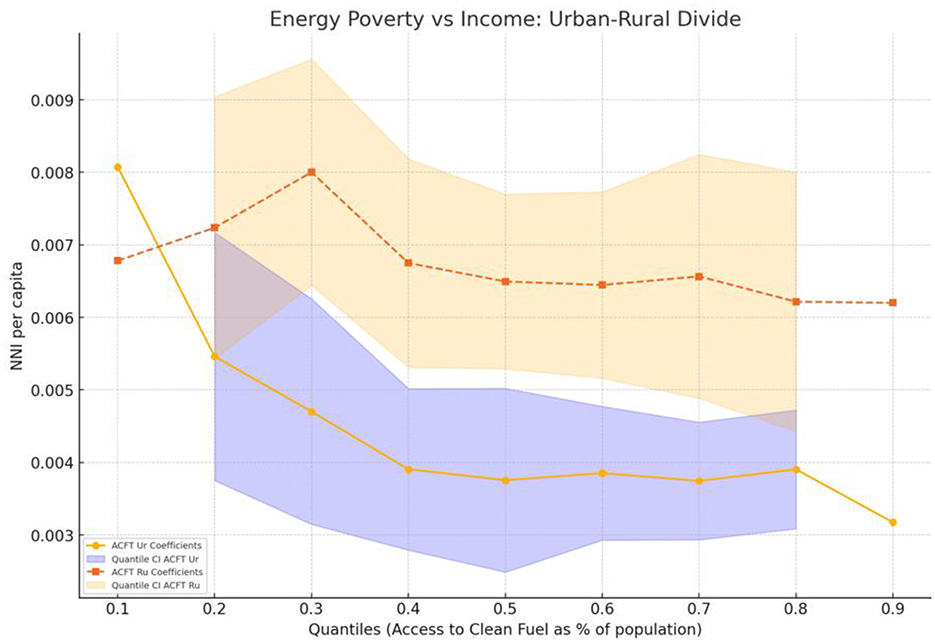
Figure 6. Rural-urban divide: influence of financial capacity on energy poverty. Source: Author's own calculations.
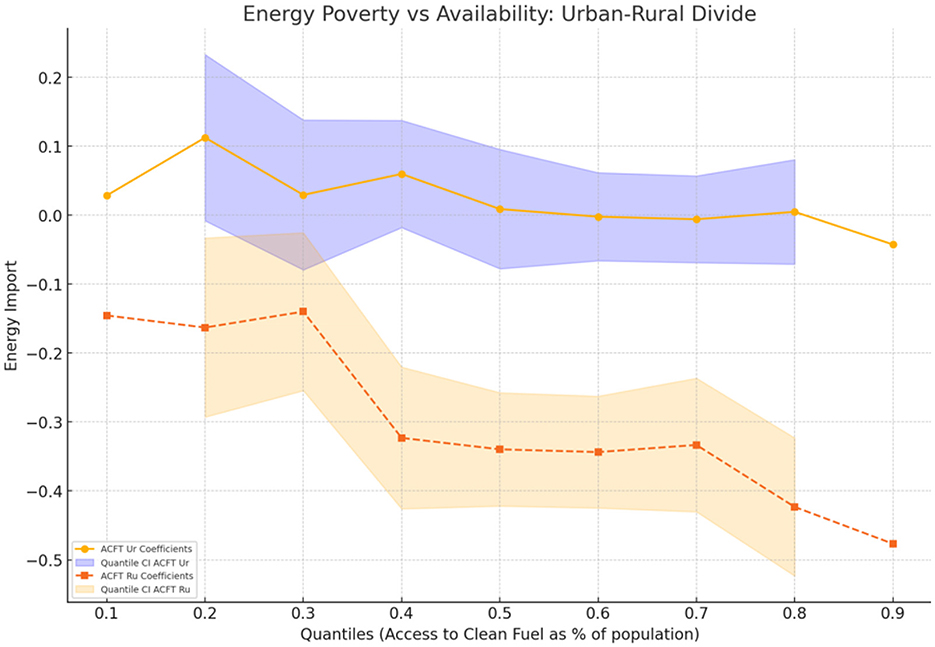
Figure 7. Rural-urban divide: influence of energy availability on Energy Poverty. Source: Author's own calculations.
Figure 8 highlights the relationship between energy efficiency, measured by GDP per unit of energy use, and energy poverty. It shows that energy-efficiency improvements initially accrue to better-served households before diffusing to the most underserved. In many BRICS rural settings, credit constraints and limited technical support slow adoption of efficient stoves and appliances, producing a transiently negative slope at lower deciles (Rao and Pachauri, 2017a,b; Alam et al., 2020a,b). Urban areas display a positive association across deciles, with a steep increase in lower quantiles, indicating the significant role of efficiency improvements in enhancing access among the least advantaged urban households. Rural areas, however, exhibit a negative relationship across most deciles, reflecting a lack of efficiency measures and resource optimization in rural settings (Reddy and Williams, 2019; UNDP, 2020a,b). Policies promoting energy-efficient technologies tailored for rural usage, such as clean cooking stoves and energy-efficient lighting, are critical for reducing rural energy poverty (Bhattacharyya, 2012). Figure 9 reveals the impact of renewable energy consumption on energy poverty. Urban areas show a consistent positive trend, particularly in higher deciles, indicating the role of renewables in improving access for households with already moderate levels of energy security. In rural areas, however, renewable energy consumption remains negatively associated with clean fuel access in lower deciles, suggesting that reliance on renewables is insufficient to overcome infrastructural barriers at the bottom of the energy access pyramid (Rao and Pachauri, 2017a,b; Sovacool and Dworkin, 2015). Investments in decentralized renewable energy systems, such as solar mini-grids, could bridge these gaps in rural energy access (Zhang and Wang, 2019a,b).
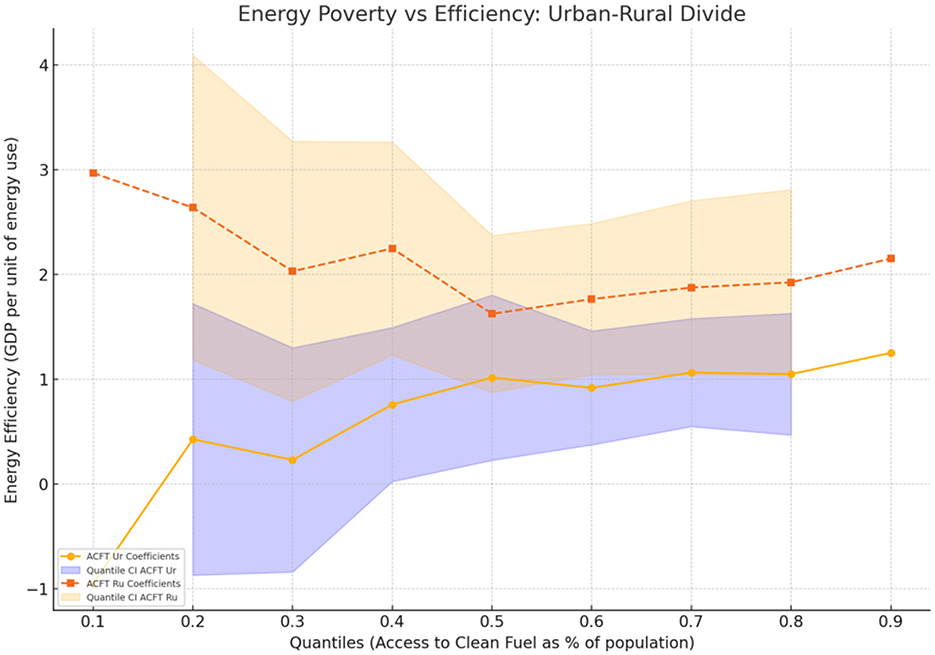
Figure 8. Rural-urban divide: influence of energy efficiency on energy poverty. Source: Author's own calculations.
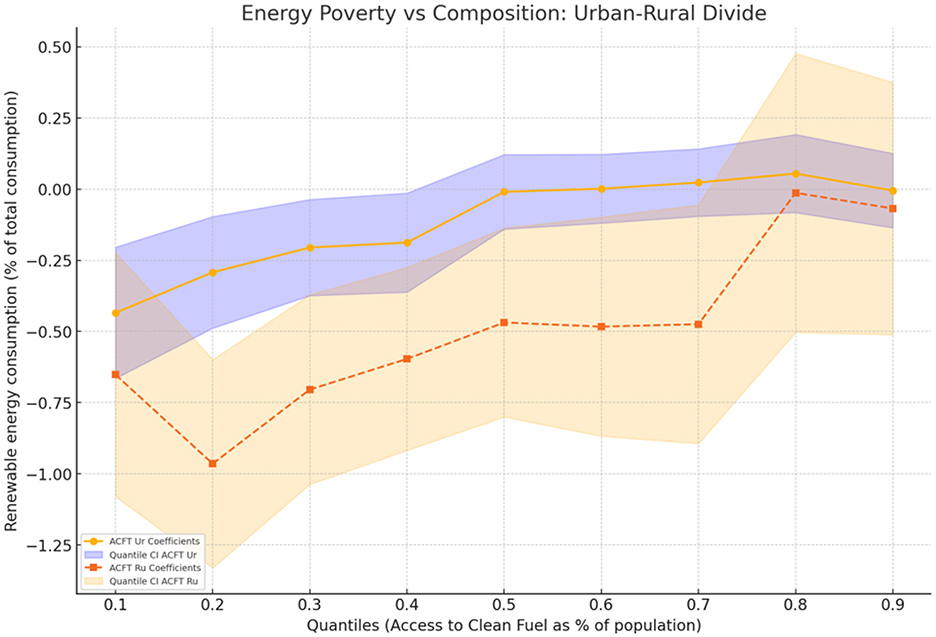
Figure 9. Rural- urban divide: influence of energy composition on energy poverty. Source: Author's own calculations.
The quantile analysis directly addresses the research questions by revealing significant rural-urban disparities in the structural determinants of energy poverty and their heterogeneity across quantiles. This approach uncovers how the effects of key determinants- energy availability, efficiency, composition, and financial capacity- vary not only between urban and rural populations but also across different levels of clean fuel access. For energy availability, the positive urban coefficients in mid-deciles highlight that energy imports predominantly benefit urban populations with moderate energy access, while rural areas face negative impacts across all quantiles due to infrastructure limitations (Bhattacharyya, 2012; Kanagawa and Nakata, 2008). Similarly, the role of renewable energy composition is more pronounced in urban settings at higher deciles, suggesting that advanced renewable energy systems are better integrated in cities, whereas rural populations struggle to translate renewables into significant energy access gains (Sovacool and Ryan, 2016; Rao and Pachauri, 2017a,b). Financial capacity, measured by NNI, shows a declining effect in urban areas across deciles, reflecting a saturation of income benefits, whereas rural areas exhibit a consistently positive association, emphasizing the critical role of income in overcoming affordability barriers for rural households (Zhang and Wang, 2019a,b; Sovacool and Dworkin, 2015). The variation in energy efficiency highlights urban advantages in leveraging technological advancements, while rural populations remain hindered by inefficiencies (Reddy and Williams, 2019; Alam et al., 2020a,b). By quantifying these disparities across quantiles, the analysis provides deeper insights into the spatial and structural dynamics of energy poverty, emphasizing the need for tailored, context-specific policy interventions (UNDP, 2020a,b; Pachauri and Rao, 2017). This decile-based analysis highlights the need for differentiated policies to address energy poverty. In urban areas, policies should focus on enhancing energy efficiency and diversifying energy sources, particularly renewables, to meet growing energy demands. In rural areas, investments in infrastructure, decentralized renewables, and income-enhancing measures are essential to bridge the energy access gap. These findings provide actionable insights for achieving Sustainable Development Goal 7 on universal energy access.
6 Policy recommendations
This research provides critical evidence to guide targeted and impactful policy measures addressing energy poverty across urban and rural areas. The findings highlight significant structural disparities in determinants such as energy availability, efficiency, composition, and financial capacity, offering key insights for crafting context-sensitive policies. Although PPP investment, Gini, and unemployment appear significant in the empirical findings, they reflect macroeconomic response effects rather than causal pathways (Rao and Pachauri, 2017a,b). Public-private partnerships often coincide with broader infrastructure or subsidy programs, absorbing fixed-effect variation (Kanagawa and Nakata, 2008). Likewise, rising Gini or unemployment can trigger targeted fuel subsidies or cash transfers that coincide with improved access (Pachauri and Rao, 2017). Consequently, income growth and energy-efficiency are the most reliable levers for expanding clean-fuel access in BRICS contexts (Reddy and Williams, 2019).
To address the rural-urban divide, policies must prioritize infrastructural investments in rural areas. The negative relationship between energy imports and rural clean fuel access indicates the need for improved distribution networks to ensure that imported energy reaches underserved populations. Developing decentralized energy systems, such as solar microgrids, can enhance rural energy access, bypassing logistical barriers associated with centralized energy systems (Bhattacharya, 2016). Urban-focused strategies should expand renewable energy integration to ensure sustained access while promoting efficient energy usage. The results underscore the increasing importance of renewable energy in improving energy access, particularly in urban regions. Policies should incentivize renewable energy investments through subsidies and public-private partnerships (Huenteler et al., 2017). Additionally, rural regions require tailored support for renewable adoption, such as training programs for local operators and financing schemes for small-scale solar and wind projects (Kumar et al., 2019; Chakraborty and Roy, 2020). The urban-rural gap in energy efficiency suggests that rural households are disadvantaged by outdated technologies and inefficient practices. Policies should focus on subsidizing energy-efficient appliances and introducing programs for retrofitting rural homes with energy-saving technologies (Blasch et al., 2018; Sovacool et al., 2021). Simultaneously, urban areas can benefit from enhanced regulations promoting green building standards and industrial energy efficiency.
The positive association of income with energy access highlights the importance of income-enhancing programs. Expanding employment opportunities in rural areas, coupled with direct financial assistance such as subsidies for clean fuels, can mitigate affordability barriers (Lee et al., 2019; Chakravarty and Tavoni, 2013). For urban populations, addressing saturation effects requires diversifying energy solutions, including flexible pricing schemes and improved energy service quality. The quantile regression results reveal heterogeneous impacts across energy access levels. Policymakers should adopt a differentiated approach by focusing on affordability and availability in lower access quantiles while addressing efficiency and renewable integration in higher access segments (Bazilian et al., 2012; Kankam and Boon, 2009). Policies must align with global sustainable development goals to achieve universal energy access. Investments in research and development for affordable clean technologies, coupled with regional collaborations, can address systemic disparities while promoting environmental sustainability (van de Graaf et al., 2019; Sovacool and Axsen, 2018). This research underscores the need for multi-dimensional, context-sensitive interventions. By integrating rural-urban disparities and quantile-specific determinants into policy frameworks, these recommendations provide a roadmap for equitable and sustainable energy transitions.
7 Conclusion
Energy poverty remains a pressing challenge in BRICS countries, where disparities in clean energy access significantly constrain socioeconomic progress and sustainable development. The need for this study arises from the critical gaps in understanding the rural-urban divide in energy poverty determinants, particularly in developing economies. Addressing this gap is crucial for achieving SDG 7, which emphasizes universal energy access by 2030. Existing literature has primarily focused on urban energy transitions or broad national trends, neglecting the nuanced heterogeneities across rural and urban contexts. This study fills this void by offering an in-depth empirical analysis of how energy availability, financial capacity, and energy efficiency influence clean energy access, emphasizing the structural challenges faced by rural populations. The research significantly mitigates the literature gap by employing robust econometric approaches, including fixed-effects, instrumental variable techniques, and quantile regressions. These methods enable a nuanced understanding of how the determinants of energy poverty vary across income levels and geographic settings. For example, the study reveals that while national net income positively impacts clean energy access in rural areas, it has limited significance in urban areas where infrastructural constraints are less severe (Bhattacharyya, 2012; Kanagawa and Nakata, 2008). Similarly, the analysis of energy imports underscores rural infrastructural deficiencies, suggesting that imported energy predominantly benefits urban populations due to inequitable distribution networks.
The study's theoretical underpinnings rest on energy justice and sustainable development frameworks, emphasizing the intersection of affordability, accessibility, and equity in energy transitions (Sovacool and Dworkin, 2015; Jenkins et al., 2016). These frameworks guide the interpretation of findings, highlighting the need for targeted interventions such as decentralized energy systems, renewable energy integration, and income-based subsidies in rural areas. The results have critical policy implications. First, they stress the importance of tailoring energy policies to address rural-urban disparities. Policymakers should prioritize infrastructure development in rural areas to overcome the logistical challenges of energy distribution. Second, the study underscores the role of financial incentives and targeted subsidies in enhancing affordability for underserved populations (Rao and Pachauri, 2017a,b). Finally, the findings advocate for decentralized renewable energy systems to address both infrastructural constraints and climate resilience goals (Zhang and Wang, 2019a,b).
This research not only advances theoretical and empirical understanding but also equips policymakers with actionable insights to design equitable and sustainable energy policies. Future studies should expand on this work by incorporating dynamic analyses of renewable energy policies and exploring the gendered dimensions of energy poverty to further enrich the discourse on equitable energy transitions. I acknowledge that separate regressions for each BRICS country would likely uncover additional heterogeneity in policy effectiveness and infrastructure constraints. Future research may conduct country-level panel and quantile analyses to refine context-sensitive interventions and deepen understanding of energy poverty dynamics within heterogeneous policy regimes.
Data availability statement
The original contributions presented in the study are included in the article/Supplementary material, further inquiries can be directed to the corresponding author.
Author contributions
AG: Conceptualization, Data curation, Formal analysis, Funding acquisition, Investigation, Methodology, Project administration, Resources, Software, Supervision, Validation, Visualization, Writing – original draft, Writing – review & editing.
Funding
The author(s) declare that no financial support was received for the research and/or publication of this article.
Conflict of interest
The author declares that the research was conducted in the absence of any commercial or financial relationships that could be construed as a potential conflict of interest.
Generative AI statement
The author(s) declare that no Gen AI was used in the creation of this manuscript.
Any alternative text (alt text) provided alongside figures in this article has been generated by Frontiers with the support of artificial intelligence and reasonable efforts have been made to ensure accuracy, including review by the authors wherever possible. If you identify any issues, please contact us.
Publisher's note
All claims expressed in this article are solely those of the authors and do not necessarily represent those of their affiliated organizations, or those of the publisher, the editors and the reviewers. Any product that may be evaluated in this article, or claim that may be made by its manufacturer, is not guaranteed or endorsed by the publisher.
Supplementary material
The Supplementary Material for this article can be found online at: https://www.frontiersin.org/articles/10.3389/frevc.2025.1552502/full#supplementary-material
Footnotes
1. ^Structural determinants of energy poverty are systemic factors like income inequality, housing quality, energy pricing, and infrastructure access that limit households' ability to afford or access adequate energy. Geographic location, policy frameworks, and social disparities exacerbate inequities, hindering basic needs like heating, lighting, and well-being (Bouzarovski and Petrova, 2015; Reames, 2016).
2. ^The structural decomposition approach in panel data econometrics analyzes changes in an outcome variable by decomposing effects into contributions from structural factors, such as economic growth, technology, or policy changes. It identifies key drivers of variations over time and across entities (Dietzenbacher and Los, 1998; Ang, 2015).
3. ^Temporal trends refer to patterns or changes observed in data or phenomena over time, highlighting shifts, growth, or declines to understand past developments and predict future trajectories (Chatfield, 2004).
4. ^Distributive justice focuses on equitable allocation of resources, opportunities, and benefits, while recognition justice emphasizes acknowledging and respecting diverse identities, cultures, and needs (Fraser, 1997).
5. ^Control variables are factors included in statistical models to account for their potential influence on the dependent variable. They help isolate the relationship between independent and dependent variables by minimizing confounding effects (Allison, 1999; Wooldridge, 2010).
References
Aklin, M., Bayer, P., Harish, S. P., and Urpelainen, J. (2018). Does basic energy access generate socioeconomic benefits? A field experiment with off-grid solar power in India. Sci. Adv. 3:e1602153. doi: 10.1126/sciadv.1602153
Alam, M. S., Blanchard, J., and McFarlane, J. (2020a). Energy efficiency as a determinant of energy poverty: evidence from emerging economies. Energy Policy 137:111128.
Alam, M. S., Siwar, C., and Talib, B. (2020b). Sustainable energy development and poverty alleviation in developing countries. Energy Policy 38, 4563–4569.
Ang, B. W. (2015). LMDI decomposition approach: a guide for implementation. Energy Policy 86, 233–238. doi: 10.1016/j.enpol.2015.07.007
Angrist, J. D., and Pischke, J-. S. (2008). Mostly Harmless Econometrics: An Empiricist's Companion. Princeton, NJ: Princeton University Press. doi: 10.2307/j.ctvcm4j72
Baland, J. M., Bardhan, P., Das, S., Mookherjee, D., and Sarkar, R. (2010). Access to finance and energy poverty: panel data evidence from India. Econ. Dev. Cult. Change 59, 269–297. doi: 10.1086/655455
Barnes, D. F., Khandker, S. R., and Samad, H. A. (2011). Energy access, efficiency, and poverty: how many households are energy poor in Bangladesh? Washington, DC: World Bank Policy Research Working Paper. doi: 10.1596/1813-9450-5332
Baum, C. F., Schaffer, M. E., and Stillman, S. (2007). Enhanced routines for instrumental variables/GMM estimation and testing. Stata J. 7, 465–506. doi: 10.1177/1536867X0800700402
Bazilian, M., Nakhooda, S., and Van de Graaf, T. (2014). Energy governance and poverty. Energy Res. Soc. Sci. 1, 217–225. doi: 10.1016/j.erss.2014.03.006
Bazilian, M., and Pielke, R. (2013). Making energy access meaningful. Issues Sci. Technol. 29, 74–78. Available online at: https://pure.iiasa.ac.at/id/eprint/10285/1/Making%20Energy%20Access%20Meaningful.pdf
Bazilian, M., Rogner, H., Howells, M., Hermann, S., Arent, D., Gielen, D., et al. (2012). Considering the energy, water and food nexus: towards an integrated modelling approach. Energy Policy 39, 7896–7906. doi: 10.1016/j.enpol.2011.09.039
Bhattacharya, S. (2016). The role of clean energy technologies in mitigating energy poverty in India. Renewable Sustain. Energy Rev. 62, 506–517.
Bhattacharyya, S. C. (2012). Energy access in developing countries: an overview. Energy Policy 47, 283–292.
Bhattacharyya, S. C., and Palit, D. (2016). Mini-grids for Rural Electrification of Developing Countries: Analysis and Case Studies from South Asia. Switzerland: Springer.
Blasch, J., Filippini, M., and Kumar, N. (2018). Boundedly rational consumers, energy efficiency, and the rebound effect. Energy Policy 123, 47–58.
Bouzarovski, S. (2014). Energy poverty in the European Union: landscapes of vulnerability. WIREs Energy Environ. 3, 276–289. doi: 10.1002/wene.89
Bouzarovski, S., and Petrova, S. (2015). A global perspective on energy poverty in Europe: a meta-analysis of vulnerability determinants. Energy Res. Soc. Sci. 10, 31–40. doi: 10.1016/j.erss.2015.06.007
Campolina, B., Chaves, L., and Carvalho, G. (2017). Energy subsidies and low-income households in Brazil. Energy Sustain. Dev. 40, 1–9.
Chakraborty, S., and Roy, J. (2020). Access to modern energy in India: an assessment of distributive outcomes. Energy Policy 144:111687.
Chakravarty, S., and Tavoni, M. (2013). Energy poverty alleviation and climate change mitigation: is there a trade-off? Energy Econ. 40, S67–S73. doi: 10.1016/j.eneco.2013.09.022
Chatfield, C. (2004). The Analysis of Time Series: An Introduction, 6th Edn. New York, NY: CRC Press.
Dietzenbacher, E., and Los, B. (1998). Structural decomposition techniques: sense and sensitivity. Econ. Syst. Res. 10, 307–324. doi: 10.1080/09535319800000023
Dincer, I. (2000). Renewable energy and sustainable development: a crucial review. Renewable Sustain. Energy Rev. 4, 157–175. doi: 10.1016/S1364-0321(99)00011-8
Dinkelman, T. (2011). The effects of rural electrification on employment: new evidence from South Africa. Am. Econ. Rev. 101, 3078–3108. doi: 10.1257/aer.101.7.3078
Foley, G. (1992). Rural energy and development. Energy Policy 20, 108–121. doi: 10.1016/0301-4215(92)90108-E
Fraser, N. (1997). Justice Interruptus: Critical Reflections on the “Postsocialist” Condition. New York, NY: Routledge.
Gaye, A. (2007). Access to Energy and Human Development. Human Development Report. New York, NY: United Nations Development Programme.
Hao, L., and Naiman, D. Q. (2007). Quantile Regression. Thousand Oaks, CA: Sage Publications. doi: 10.4135/9781412985550
Healy, J. D., and Clinch, J. P. (2002). Fuel poverty, thermal comfort, and health. Energy Policy 30, 411–421.
Huenteler, J., Niebuhr, C., and Schmidt, T. S. (2017). The effect of local and global learning on the cost of renewable energy in developing countries. J. Cleaner Prod. 147, 605–616.
International Energy Agency (IEA) (2021). World Energy Outlook 2021. Paris: IEA. Available online at: https://iea.blob.core.windows.net/assets/4ed140c1-c3f3-4fd9-acae-789a4e14a23c/WorldEnergyOutlook2021.pdf
Jenkins, K., McCauley, D., and Heffron, R. (2016). Energy justice: a conceptual review. Energy Res. Soc. Sci. 11, 174–182. doi: 10.1016/j.erss.2015.10.004
Kanagawa, M., and Nakata, T. (2008). Assessment of access to electricity and the socio-economic impacts in rural areas of developing countries. Energy Policy 36, 2016–2029. doi: 10.1016/j.enpol.2008.01.041
Kankam, S., and Boon, E. K. (2009). Energy delivery and utilization for rural development: lessons from Northern Ghana. Energy Sustain. Dev. 13, 212–218. doi: 10.1016/j.esd.2009.08.002
Khandker, S. R., Barnes, D. F., and Samad, H. A. (2010). Energy Poverty in Rural and Urban India: Are the Energy Poor also Income Poor? Washington, DC: World Bank Policy Research Working Paper.
Khandker, S. R., Barnes, D. F., and Samad, H. A. (2012). The welfare impacts of rural electrification in Bangladesh. Energy J. 33, 187–206. doi: 10.5547/ISSN0195-6574-EJ-Vol33-No1-7
Koenker, R. (2005). Quantile Regression. Cambridge, MA: Cambridge University Press. doi: 10.1017/CBO9780511754098
Koenker, R., and Bassett, G. (1978). Regression Quantiles. Econometrica 46, 33–50. doi: 10.2307/1913643
Kumar, S., Mohapatra, S., and Khuntia, J. (2019). Financing energy access and off-grid energy solutions: challenges and opportunities. Energy Policy 132, 267–273.
Lee, K., Miguel, E., and Wolfram, C. (2019). Experimental evidence on the economics of rural electrification. J. Polit. Econ. 128, 1523–1565. doi: 10.1086/705417
Li, J., Li, J., Guo, K., and Ji, Q. (2024). Policy spillovers from climate actions to energy poverty: international evidence. Hum. Soc. Sci. Commun. 11, 1–12. doi: 10.1057/s41599-024-03614-0
Matinga, M. N., and Annegarn, H. J. (2013). Paradoxical impacts of biomass energy use on gender-based development. Energy Sustain. Dev. 17, 224–232.
Modi, V., McDade, S., Lallement, D., and Saghir, J. (2006). Energy and the millennium development goals. Energy Policy 34, 362–375. Available online at: https://www.undp.org/sites/g/files/zskgke326/files/publications/MP_Energy2006.pdf
Monyei, C. G., Adewumi, K. A., and Jenkins, K. E. (2018). Energy poverty and socio-economic inequalities in South Africa. Energy Res. Soc. Sci. 40, 205–214. doi: 10.1016/j.enpol.2017.09.039
Pachauri, S., and Rao, N. D. (2017). Gender impacts of energy poverty alleviation in rural areas. Energy Econ. 38, 86–98.
Pachauri, S., and Spreng, D. (2011). Measuring and monitoring energy poverty. Energy Policy 39, 7497–7504. doi: 10.1016/j.enpol.2011.07.008
Pesaran, M. H. (2004). General Diagnostic Tests for Cross-Sectional Dependence in Panels. Munich: CESifo Working Paper Series No. 1229. doi: 10.2139/ssrn.572504
Ranjan, R., and Hughes, L. (2014). Energy security and the diversity of energy flows in an energy system. Energy 73, 137–144. doi: 10.1016/j.energy.2014.05.108
Rao, N. D., and Pachauri, S. (2017a). Energy access and living standards: some observations on recent trends. Energy Policy 35, 219–227. doi: 10.1088/1748-9326/aa5b0d
Rao, N. D., and Pachauri, S. (2017b). Energy poverty and its implications for climate change and sustainable development. Ann. Rev. Environ. Resour. 42, 59–84.
Reames, T. G. (2016). Targeting energy justice: exploring spatial, racial/ethnic, and socioeconomic disparities in urban residential heating energy efficiency. Energy Policy 97, 549–558. doi: 10.1016/j.enpol.2016.07.048
Reddy, A. K. N., and Williams, R. H. (2019). Energy for sustainable development: key issues and challenges. Energy Policy 27, 555–573.
Sahoo, A., and Shrimali, G. (2013). Renewable energy policy in India: addressing energy poverty and climate mitigation. Energy Policy 52, 729–738.
Sánchez, T. (2010). The hidden energy crisis: how policies drive energy poverty in Latin America. Energy Policy 38, 6565–6575. doi: 10.3362/9781780440231.000
Sovacool, B. K. (2012). The political economy of energy poverty: a review of key challenges. Energy Sustain. Dev. 16, 272–282. doi: 10.1016/j.esd.2012.05.006
Sovacool, B. K. (2018). Policy innovation and energy poverty alleviation in BRICS countries. Energy Res. Soc. Sci. 44, 120–132. doi: 10.1016/j.erss.2018.07.007
Sovacool, B. K., and Axsen, J. (2018). Functional, symbolic and societal frames for automobility: implications for sustainability transitions. Transp. Res. Part A Policy Pract. 118, 730–746. doi: 10.1016/j.tra.2018.10.008
Sovacool, B. K., and Dworkin, M. H. (2015). Global energy justice. Nat. Energy 1:16010. doi: 10.1038/nenergy.2016.24
Sovacool, B. K., Mukherjee, I., Drupady, I. M., and D'Agostino, A. L. (2012). Evaluating energy security performance from 1990 to 2010 for eighteen countries. Energy 36, 5846–5853. doi: 10.1016/j.energy.2011.08.040
Sovacool, B. K., and Ryan, S. E. (2016). Energy security, poverty, and justice. Ann. Rev. Environ. Resour. 41, 327–353. doi: 10.1088/1748-9326/11/6/064014
Sovacool, B. K., van de Graaf, T., and Andrews, N. (2021). Energy justice and COVID-19: global perspectives on the fair distribution of energy during a pandemic. Energy Res. Soc. Sci. 68:101610. doi: 10.1016/j.erss.2020.101701
Stepanova, A. (2020). Energy poverty and infrastructure inefficiencies in rural Russia. Energy Policy 138, 111232.
Tharakan, P. J., Krohn, S., Hansen, L., and Christopher, T. (2014). Offshore wind energy policies, markets, and planning. Energy Policy 39, 878–890. doi: 10.1109/PEDES.2016.7914319
UNDP (2020a). Sustainable Energy for All: Delivering on the Promise of Universal Energy Access. New York, NY: United Nations Development Programme.
United Nations (2023). The Sustainable Development Goals Report 2023: Special Edition. New York, NY: UN Department of Economic and Social Affairs.
van de Graaf, T., Overland, I., Scholten, D., and Westphal, K. (2019). The new oil? The geopolitics and international governance of hydrogen. Energy Res. Soc. Sci. 70:101667. doi: 10.1016/j.erss.2020.101667
Wang, Q., and Lin, B. (2017). Affordability and energy poverty in urban China: a review of household surveys. Energy Policy 110, 258–266.
White, H. (1980). A heteroskedasticity-consistent covariance matrix estimator and a direct test for heteroskedasticity. Econometrica 48, 817–838. doi: 10.2307/1912934
Wooldridge, J. M. (2010). Econometric Analysis of Cross Section and Panel Data. Cambridge, MA: MIT Press.
World Bank (2021b). The Role of Energy in Poverty Reduction: A Global Review. Washington, DC: World Bank.
World Bank (2024). Tracking SDG 7: The Energy Progress Report 2024. Washington, DC: World Bank Group.
Zhang, D., Zhang, X., and Lai, K. (2018). Renewable energy, energy efficiency, and energy poverty in China: a review. Renewable Sustain. Energy Rev. 98, 164–171. doi: 10.1016/j.rser.2018.09.023
Zhang, Y., and Wang, C. (2019a). Regional disparities in energy poverty and policies in China. Energy Policy 125, 75–86.
Keywords: energy poverty, rural-urban disparities, BRICS economies, quantile regression, energy access determinants
Citation: Ghosh A (2025) Decoding energy poverty: rural-urban disparities and structural barriers in BRICS countries. Front. Environ. Econ. 4:1552502. doi: 10.3389/frevc.2025.1552502
Received: 25 February 2025; Accepted: 25 September 2025;
Published: 22 October 2025.
Edited by:
Mohammed Ben-idris, Michigan State University, United StatesReviewed by:
Jorge Cunha, University of Minho, PortugalMatthew Egan, Michigan State University, United States
Copyright © 2025 Ghosh. This is an open-access article distributed under the terms of the Creative Commons Attribution License (CC BY). The use, distribution or reproduction in other forums is permitted, provided the original author(s) and the copyright owner(s) are credited and that the original publication in this journal is cited, in accordance with accepted academic practice. No use, distribution or reproduction is permitted which does not comply with these terms.
*Correspondence: Avik Ghosh, YXZpa2dob3NoQHJiaS5vcmcuaW4=
 Avik Ghosh
Avik Ghosh